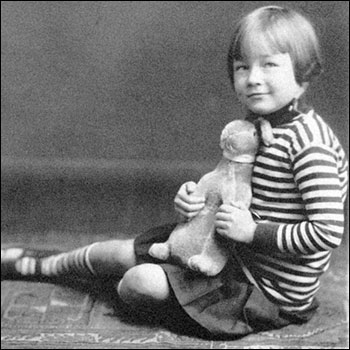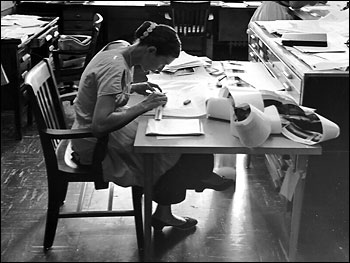

Discovering the Thrill of ScienceBorn in Boston, Massachusetts, on March 23, 1923, Joanne Gerould did not have an ideal childhood. Watching her mother struggle through a bad marriage and subsequent divorce gave Simpson a strong drive to be self-sufficient. “There were many times my mother stated, ’If it weren’t for you children, I would go back and earn my living,’” she recounts. “I made up my mind, I think by the time I was ten years old, that there was absolutely no way I was going to get myself into that sort of situation. No matter what happened, I was going to be able to make my own living and to provide for whatever children I might have without depending on anybody else.” 
Joanne Simpson was born in Boston, Massachusetts, in 1923, and posed for this photo at age 5. She became interested in weather and clouds while sailing off Cape Cod. (Photograph courtesy Joanne Simpson and the Schlesinger Library) Simpson recalls that she was fascinated by clouds as she sailed her small catboat off Cape Cod. But she didn’t get excited about science until she entered the University of Chicago, where she took a course in astrophysics. “Had it not been for World War II, I probably would have tried to go into astrophysics,” she says. But as a student pilot, she had to take course in meteorology. She was fascinated and asked the instructor if the university had any more courses in meteorology. He told her that Carl-Gustaf Rossby, who many still consider to be the greatest meteorologist ever, had just arrived at the University of Chicago to set up an institute of meteorology. “I made an appointment with him, went into his office, and ten minutes later, I was in the World War II meteorology program as a teacher-in-training,” says Simpson. Until the war ended, she had great fun teaching meteorology to Aviation Cadets, many older than herself. After the war, women were supposed to go home and get behind a mop, but Simpson was more interested in weather than housework. She completed her Masters Degree and wanted to go into the Ph.D. program. The Faculty Advisor told her and two other women that no woman ever got a Ph.D. in Meteorology, none ever would, and if any of them did, she would never be given a job. Simpson struggled on with student loans. After completing a course with Herbert Riehl on tropical meteorology, she decided to concentrate on tropical cumulous clouds and asked Riehl if he would be her Ph.D. advisor. To her and everyone’s surprise he agreed. 

Simpson’s early research at Woods Hole involved filming clouds on long flights between islands in the tropical Pacific. She then drew intricate maps of cloud formations, revealing for the first time patterns that are now routinely shown by satellites. Her work helped show the critical role tropical clouds play in global atmospheric circulation. (Photograph courtesy Joanne Simpson and the Schlesinger Library; Map from Malkus and Riehl, 1964) At the time, nobody thought clouds were a big part of what drives the weather; they were more the result of weather, not the cause. “So I was interested in clouds for just themselves because they were fascinating,” explains Simpson. Rossby said that no one was very interested in them, so it was a good subject “for a little girl to study.” Despite the hostility and guffaws she received from some of the all-male faculty at the University of Chicago along the way, Simpson went on to become the first woman to hold a Ph.D. in meteorology.
next: “Hot Tower” Hypothesis
|
| ||